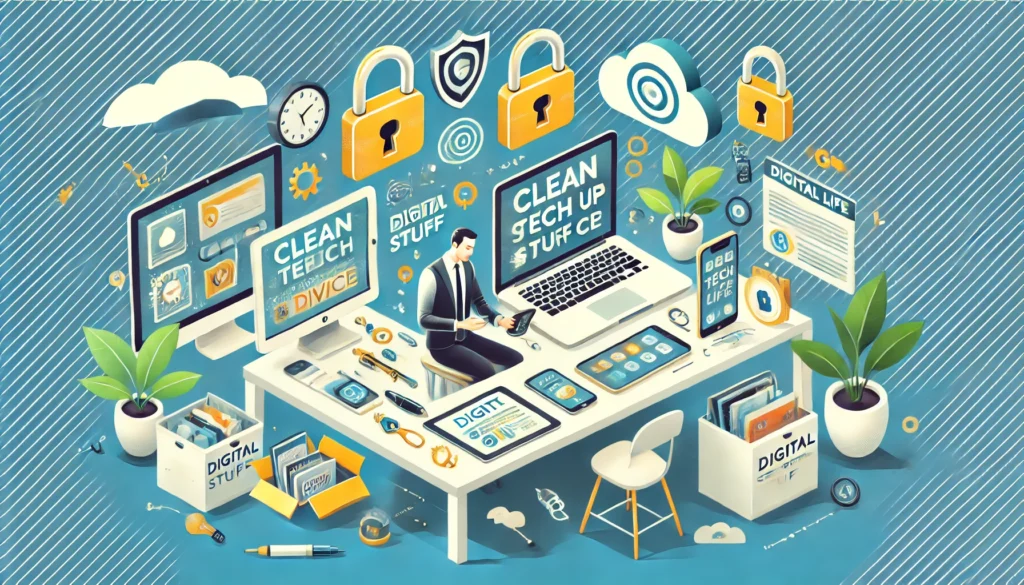Going through a divorce is tough, but figuring out how to clean tech stuff up post divorce can be a crucial step in securing your digital life and moving forward. Shared devices, accounts, and personal data can create ongoing issues if not handled properly. In this guide, we’ll walk through practical steps to clean up your technology after divorce and ensure that your online presence is secure. Whether it’s resetting passwords, updating privacy settings, or even seeking professional help, these steps will help you regain control over your tech life post-divorce.
1. Why Tech Cleanup Is Critical Post Divorce
In today’s world, technology intertwines deeply with our lives. From emails to cloud storage, smart home devices to social media, tech plays a major role in everyday interactions. After a divorce, cleaning up your tech is not just about severing digital ties—it’s about protecting your privacy, security, and personal data. Divorce often leaves many loose ends, especially when it comes to shared devices and accounts. If not handled correctly, these loose ends could lead to complications down the road.
2. Backing Up Your Data Before Cleanup
Before you dive into securing your tech life post-divorce, it’s important to back up your data. Many people forget this crucial step. Backing up data ensures that you don’t lose important files like photos, documents, and financial records while cleaning up.
Why Backup Is the First Step
Imagine losing years of important memories or crucial legal documents because you wiped a device too quickly. By backing up data to a secure cloud service (like Google Drive or iCloud) or an external hard drive, you guarantee that all your vital information is preserved.
How to Back Up Safely and Securely
Use encrypted cloud services or secure external storage devices. Make sure the new backup is completely separate from any shared accounts you had with your ex, ensuring only you have access.
3. Creating a New Email and Updating Communication Channels
One of the first things to do post-divorce is to create a new email address. Your ex may still have access to your old one, which could lead to unwanted access to personal communications and sensitive data.
Why a New Email Is Essential
This helps prevent unauthorized access to your accounts and sensitive conversations. Use a strong, unique email that isn’t easily guessed by your ex. Services like Gmail or Outlook are great options for secure emails.
How to Use It
Once created, use this new email for all important communication, especially for legal and financial matters. Make sure to update this email across all key online platforms like your bank, insurance accounts, and even your lawyer.
4. Changing Passwords and Security Settings
Passwords are the keys to your online life. If your ex knows or had access to any of your old passwords, it’s crucial to change them.
Creating Strong Passwords
A secure password should include a mix of uppercase letters, lowercase letters, numbers, and symbols. Avoid using anything easily guessable like names, birthdays, or common phrases.
Using Password Managers
Since keeping track of different, complex passwords can be difficult, a password manager (like LastPass or 1Password) can help securely store and organize them. This ensures that you’re not tempted to reuse the same password across multiple platforms.
5. Handling Shared Devices and Accounts
A common post-divorce challenge is dealing with shared devices like smart home systems, laptops, and even shared subscriptions like Netflix or Spotify. These need to be handled carefully to ensure privacy and prevent unauthorized access.
Dealing with Shared Financial Accounts and Subscriptions
For services like Netflix or financial apps, make sure to remove your ex from the account. If necessary, cancel the account entirely and create a new one. For joint financial accounts, consult with your lawyer on the best approach to separating these.
Securing Smart Home Devices and Computers
Devices such as smart speakers, shared tablets, or computers can still be logged into by your ex. Reset all devices to factory settings, ensuring they no longer have access. Update login credentials for any shared accounts that are linked to these devices.
6. Updating Privacy Settings and Removing Access
Now that you’ve changed your passwords and secured devices, it’s time to update privacy settings across all your online accounts.
Disconnecting from Cloud Services and Social Media
Go through your Apple ID, Google account, and cloud storage settings to revoke access from any devices your ex may still have. On social media, review and update your privacy settings to make sure only close friends and family have access to your posts.
Steps for Revoking Device Access
For services like iCloud, Find My iPhone, or Google Maps, make sure to remove any shared location services that your ex may still have access to.
7. Enabling Two-Factor Authentication (2FA)
To add an extra layer of protection to your accounts, enable two-factor authentication (2FA). This security feature ensures that even if someone has your password, they cannot access your account without a secondary verification code sent to your phone.
Benefits of 2FA for Post-Divorce Privacy
Two-factor authentication is a simple yet powerful tool that adds a safeguard against unauthorized logins. Most major services like Google, Facebook, and banking apps offer this option.
How to Set It Up
Go to the security settings of each account and follow the steps to enable 2FA. You can opt for SMS-based codes or use an authentication app like Google Authenticator.
8. Resetting Biometric Data
Modern devices often use biometric data like fingerprints or facial recognition for security. Post-divorce, it’s essential to reset these features on any shared devices.
Securing Fingerprint or Face Recognition Access
Go into your device settings and reset all biometric data to ensure that your ex’s fingerprints or face ID no longer work. Make sure only your data is stored for future use.
9. Getting Professional Help if Needed
Sometimes, cleaning up your tech after a divorce can be overwhelming, especially if there are complex financial, business, or legal ties. Don’t hesitate to seek professional help if needed.
When to Seek Legal or Tech Support
If you’re unsure how to separate joint accounts or need assistance in securing sensitive data, reach out to a tech expert or a lawyer who specializes in divorce-related technology issues. They can help ensure all your bases are covered.
Conclusion
Taking control of your tech life post-divorce is an essential step toward reclaiming your privacy and peace of mind. Whether it’s creating new emails, changing passwords, or resetting devices, following these steps can safeguard your digital world and prevent potential issues in the future.
Here’s a recap of what you need to do:
- Back up your data before starting the cleanup.
- Create a new, secure email for important communications.
- Change all your passwords and enable two-factor authentication.
- Handle shared devices and accounts carefully, ensuring your ex no longer has access.
- Update privacy settings across all platforms and disconnect from shared services.
- Reset biometric data on any shared devices.
- Seek professional help if needed.
By following these steps, you’ll not only secure your tech but also start your post-divorce life with the digital peace of mind you deserve. Now you know how to clean tech stuff up post divorce and can move forward confidently.


